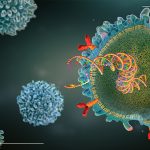Scientists at Nanyang Technological University, Singapore (NTU Singapore) have mapped out the chemical structure of telomeres, which play an important role in ageing and cancer. The NTU team observed that the telomere building pieces are packed in columns like a spring. They also discovered that the form of telomeres exposes and unprotects a portion of the DNA, making it more vulnerable to damage than previously assumed. According to the researchers, their advances in genetic research will help understand why humans age and get cancer. Cancer is often an age-related genetic illness that manifests only when normal cells develop genomic instability over time and gain the ability to replicate immortally. Telomere attrition causes chromosomal instability and contributes considerably to genomic rearrangements that might result in cancer. Telomeres, which are repeated (TTAGGG) DNA-protein complexes at the ends of chromosomes, are essential for cancer cell survival. In the great majority of cancers, they are maintained by an enzyme called telomerase. The mechanisms underlying telomere length (TL) maintenance and telomerase expression involve transcriptional, post-transcriptional, and epigenetic regulation, and a thorough understanding of these mechanisms may lead to the development of novel biomarkers and targets for disease detection, disease prognosis, and therapeutic development.
Telomeres are caps that protect the ends of the DNA molecules that make up our chromosomes. The job of telomeres, like the plastic tips on the ends of shoelaces, is to cap and prevent the ends of the chromosome from hurting themselves by clinging to one other or fraying. A telomere is an end-of-chromosome segment comprising repeated DNA sequences. Telomeres keep the ends of chromosomes from fraying or tangling. Telomeres shorten gradually each time a cell divides. They eventually get so short that the cell can no longer divide properly and dies.
Telomeres are responsible for maintaining genomic integrity in normal cells, and their gradual shortening during cell divisions causes chromosomal instability. Telomere length is maintained by telomerase in the vast majority of cancer cells. Thus, telomere length and telomerase activity are critical for tumour initiation and survival. Several telomere length-regulating processes have been found, and genome-scale investigations have aided in the identification of genes implicated in telomere length management. ATRX and DAXX are two examples of genes involved in the alternative telomere lengthening pathway that have undergone mutation. Genomic screening for these mutations has also shown how these genomic alterations affect the activation of telomere maintenance mechanisms in cancer cells. Attempts have also been made to create diagnostic tools and anticancer treatments based on telomere length and telomerase. Recent research has uncovered essential elements of telomerase assembly, intracellular transport, and recruitment to telomeres for DNA synthesis, which may present fresh targets for anticancer drug development.
Previously, scientists struggled to replicate enough telomeric DNA in the laboratory to use electron microscopes to see how it is constructed due to its chemical instability and intricate repeating nature. The researchers utilised existing techniques to duplicate DNA and discovered that in telomeres, nucleosomes, which contain densely packed strands of DNA (deoxyribonucleic acid), are stacked in columns around chromosomal proteins called histones. According to Professor Lars Nordenskiöld, Chair of NTU’s School of Biological Sciences and study leader, telomeres are not formed in the zig-zag configuration represented in textbooks, but rather in columns and a spring shape. This exposes the DNA’s helix, which is its most important component. This explains why telomeres are hotspots for DNA damage despite playing a crucial function in avoiding DNA damage. As there is a dearth of in-depth studies on the DNA structure of telomeres and outside influences, such as proteins and other cell processes, this study will aid scientists and physicians in understanding the mechanisms underlying how telomeres are destroyed at a molecular level.
The study underlines NTU’s commitment in responding to the demands and problems of healthy living and ageing, which is one of four big issues that the University aspires to address through its NTU 2025 strategic plan. The researchers examined the structure of telomeres using a cutting-edge cryogenic electron microscope at the NTU Institute of Structural Biology. In addition to raising awareness about how telomeres are involved in processes like ageing and DNA damage, the findings of the NTU research team may be helpful in developing potential treatments for diseases brought on by dysfunctional telomeres. The study, which advances our understanding of the biology that underlies how the human body ages and develops disease susceptibility, demonstrates NTU’s dedication to meeting the demands and difficulties associated with healthy ageing and living, one of the four grand challenges facing humanity that the University seeks to address through its NTU 2025 strategic plan. The NTU Institute of Structural Biology’s cutting-edge cryogenic electron microscope was employed by the researchers to examine the structure of telomeres in order to reach their conclusions. The discoveries of the NTU research team may also be helpful in creating possible therapies for diseases that are brought on by malfunctioning telomeres, in addition to expanding awareness of how telomeres are involved in processes like ageing and DNA damage.
These include dyskeratosis congenita, a rare hereditary type of bone marrow failure and the inability of the marrow to create enough blood cells, which often leads in death by the age of 30. Aplastic anaemia is a condition in which the body stops creating enough new blood cells. The study’s co-author, Dr. Aghil Soman, Research Fellow at NTU’s School of Biological Sciences, stated that a key area of interest in the study of DNA in the future will be how our structure interacts with already known telomere-specific factors, with a particular emphasis on factors linked to cancer development and longevity. The structure offers a way to enhance small molecule cancer treatments. They may now be able to create anticancer medications that specifically and effectively target telomeres thanks to their knowledge of the structure of telomeric nucleosome assemblies. This would help get around the drawback of medications like cisplatin, which, despite killing cancer cells in people, also harms the kidneys, liver, and brain.
The discovery of the molecular organisation of proteins in telomeres in this study lays the path for future structural research. This has the potential to give information on the structure-function link of telomeres in the context of ageing and cancer. It can also serve as a model for developing remedies for hereditary illnesses. Scientists observed exquisite grooves produced by DNA in this study, which suggests how telomere remodelling may occur. This might pave the way for future drug-targeting investigations at the telomeric level.
Reference:
- https://www.nature.com/articles/s41586-022-05236-5
- https://www.genome.gov/genetics-glossary/Telomere#:~:text=A%20telomere%20is%20a%20region,successfully%2C%20and%20the%20cell%20dies.
- https://www.ncbi.nlm.nih.gov/pmc/articles/PMC4915101/

MDForLives is a vibrant community of healthcare professionals and patients dedicated to shaping the future of healthcare. We provide valuable global insights to healthcare companies through online surveys, interviews, and discussion forums.





